service indicator VOLVO S60 2007 User Guide
[x] Cancel search | Manufacturer: VOLVO, Model Year: 2007, Model line: S60, Model: VOLVO S60 2007Pages: 200, PDF Size: 4.03 MB
Page 122 of 200
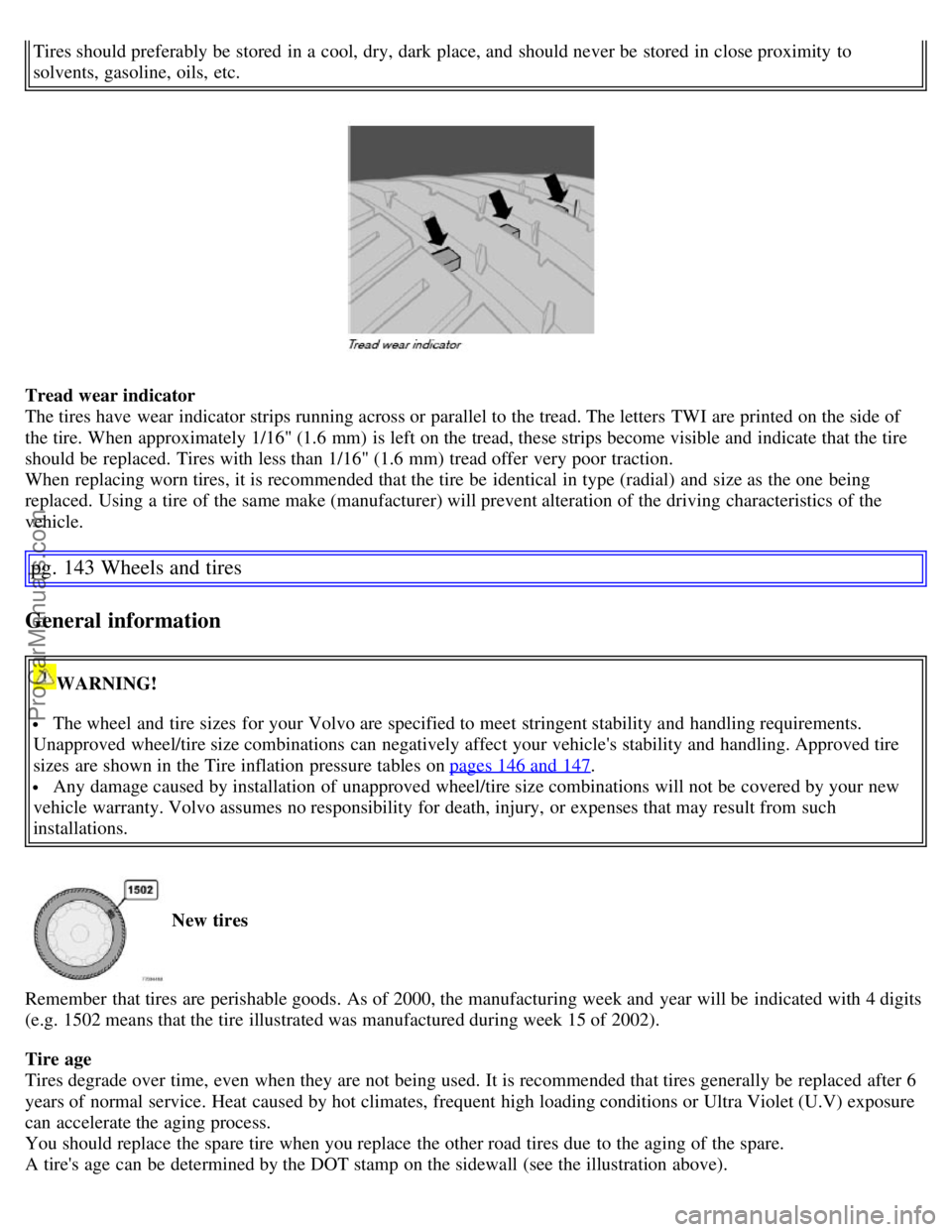
Tires should preferably be stored in a cool, dry, dark place, and should never be stored in close proximity to
solvents, gasoline, oils, etc.
Tread wear indicator
The tires have wear indicator strips running across or parallel to the tread. The letters TWI are printed on the side of
the tire. When approximately 1/16" (1.6 mm) is left on the tread, these strips become visible and indicate that the tire
should be replaced. Tires with less than 1/16" (1.6 mm) tread offer very poor traction.
When replacing worn tires, it is recommended that the tire be identical in type (radial) and size as the one being
replaced. Using a tire of the same make (manufacturer) will prevent alteration of the driving characteristics of the
vehicle.
pg. 143 Wheels and tires
General information
WARNING!
The wheel and tire sizes for your Volvo are specified to meet stringent stability and handling requirements.
Unapproved wheel/tire size combinations can negatively affect your vehicle's stability and handling. Approved tire
sizes are shown in the Tire inflation pressure tables on pages 146 and 147
.
Any damage caused by installation of unapproved wheel/tire size combinations will not be covered by your new
vehicle warranty. Volvo assumes no responsibility for death, injury, or expenses that may result from such
installations.
New tires
Remember that tires are perishable goods. As of 2000, the manufacturing week and year will be indicated with 4 digits
(e.g. 1502 means that the tire illustrated was manufactured during week 15 of 2002).
Tire age
Tires degrade over time, even when they are not being used. It is recommended that tires generally be replaced after 6
years of normal service. Heat caused by hot climates, frequent high loading conditions or Ultra Violet (U.V) exposure
can accelerate the aging process.
You should replace the spare tire when you replace the other road tires due to the aging of the spare.
A tire's age can be determined by the DOT stamp on the sidewall (see the illustration above).
ProCarManuals.com
Page 126 of 200

235/40R1839(270)39(270)35 (240) 35 (240)
Temporary spare tire
T125/80R17 61 (420)
61 (420)61 (420) 61 (420)
S60 R
235/45R17
235/40R18 39(270)
39(270)35 (240) 35 (240)
Temporary spare tire
T115/85R18 61 (420)
61 (420)61 (420) 61 (420)
pg. 148 Wheels and tires
Tire Pressure Monitoring System (TPMS) - option on certain U.S. models only
The tire pressure monitoring system uses sensors mounted in the tire valves to check inflation pressure levels. When
the vehicle is moving at a speed of approximately 20 mph (30 km/h) or faster, these sensors transmit inflation pressure
data to a receiver located in the vehicle.
USA - FCC ID: MRXTG315AM04
This device complies with part 15 of the FCC rules. Operation is subject to the following conditions: (1) This device
may not cause harmful interference, and (2) this device must accept any interference received, including interference
that may cause undesired operation.
When low inflation pressure is detected, TPMS will light up the tire pressure warning light (
) (also referred to as a
telltale) in the instrument panel, and will display a message in the text window. The wording of this message is
determined by the degree of inflation pressure loss.
NOTE: If a fault occurs in TPMS, the tire pressure warning light will flash for approximately 1 minute and TIRE
PRESS SYST SERVICE REQUIRED will be displayed.
Each tire, including the spare (if provided), should be checked monthly when cold and inflated to the inflation pressure
recommended by the vehicle manufacturer on the vehicle placard or tire inflation pressure label. (If your vehicle has
tires of a different size than the size indicated on the vehicle placard or tire inflation pressure label, you should
determine the proper tire inflation pressure for those tires.)
As an added safety feature, your vehicle has been equipped with a tire pressure monitoring system (TPMS) that
illuminates a low tire pressure telltale when one or more of your tires is significantly under-inflated. Accordingly,
when the low tire pressure telltale illuminates, you should stop and check your tires as soon as possible, and inflate
them to the proper pressure. Driving on a significantly under-inflated tire causes the tire to overheat and can lead to
tire failure. Under-inflation also reduces fuel efficiency and tire tread life, and may affect the vehicle's handling and
stopping ability.
Please note that the TPMS is not a substitute for proper tire maintenance, and it is the driver's responsibility to
maintain correct tire pressure, even if under-inflation has not reached the level to trigger illumination of the TPMS low
tire pressure telltale.
Your vehicle has also been equipped with a TPMS malfunction indicator to indicate when the system is not operating
properly. The TPMS malfunction indicator is combined with the low tire pressure telltale. When the system detects a
malfunction, the telltale will flash for approximately one minute and then remain continuously illuminated. This
sequence will continue upon subsequent vehicle start-ups as long as the malfunction exists. When the malfunction
indicator is illuminated, the system may not be able to detect or signal low tire pressure as intended. TPMS
malfunctions may occur for a variety of reasons, including the installation of replacement or alternate tires or wheels
ProCarManuals.com
Page 153 of 200
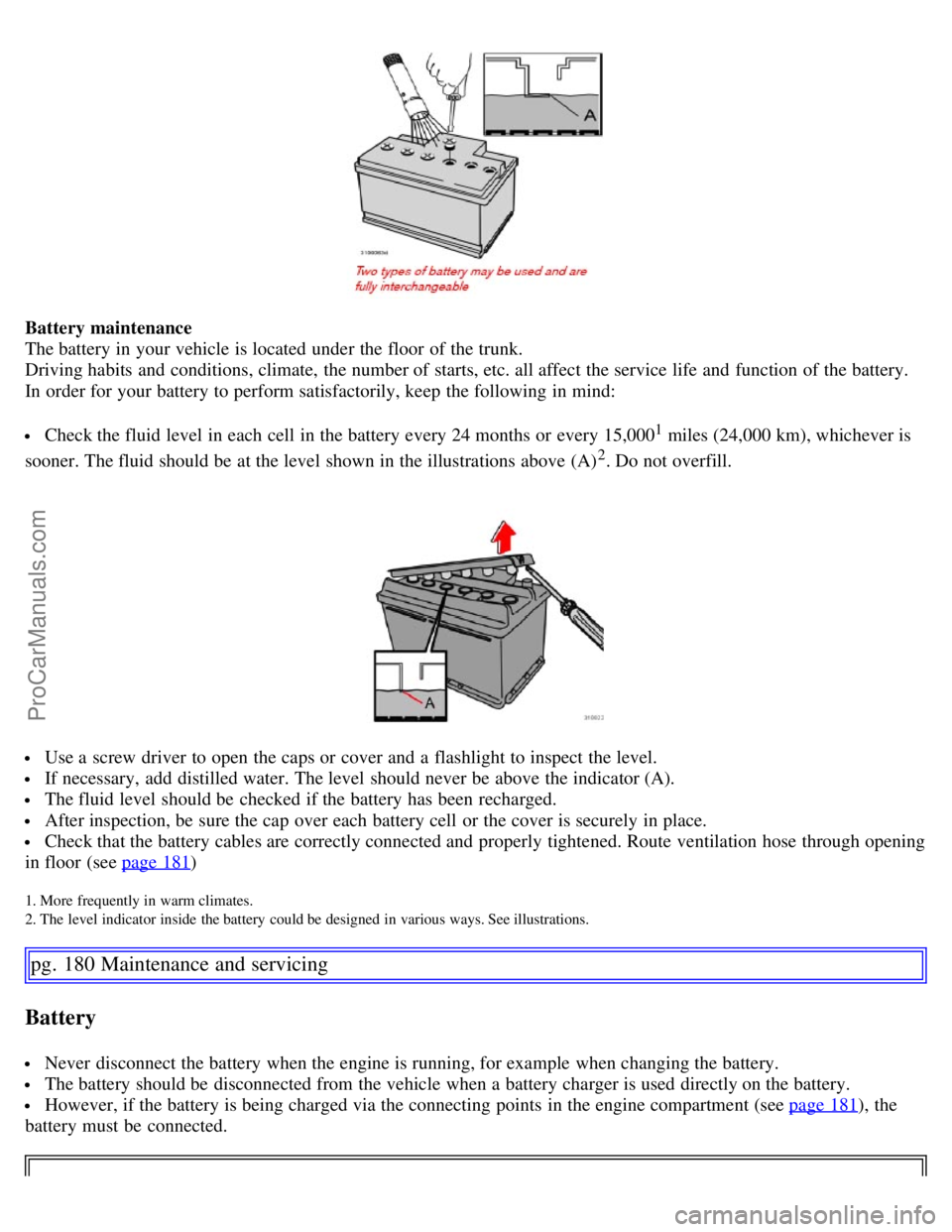
Battery maintenance
The battery in your vehicle is located under the floor of the trunk.
Driving habits and conditions, climate, the number of starts, etc. all affect the service life and function of the battery.
In order for your battery to perform satisfactorily, keep the following in mind:
Check the fluid level in each cell in the battery every 24 months or every 15,0001 miles (24,000 km), whichever is
sooner. The fluid should be at the level shown in the illustrations above (A)
2. Do not overfill.
Use a screw driver to open the caps or cover and a flashlight to inspect the level.
If necessary, add distilled water. The level should never be above the indicator (A).
The fluid level should be checked if the battery has been recharged.
After inspection, be sure the cap over each battery cell or the cover is securely in place.
Check that the battery cables are correctly connected and properly tightened. Route ventilation hose through opening
in floor (see page 181
)
1. More frequently in warm climates.
2. The level indicator inside the battery could be designed in various ways. See illustrations.
pg. 180 Maintenance and servicing
Battery
Never disconnect the battery when the engine is running, for example when changing the battery.
The battery should be disconnected from the vehicle when a battery charger is used directly on the battery.
However, if the battery is being charged via the connecting points in the engine compartment (see page 181), the
battery must be connected.
ProCarManuals.com
Page 196 of 200
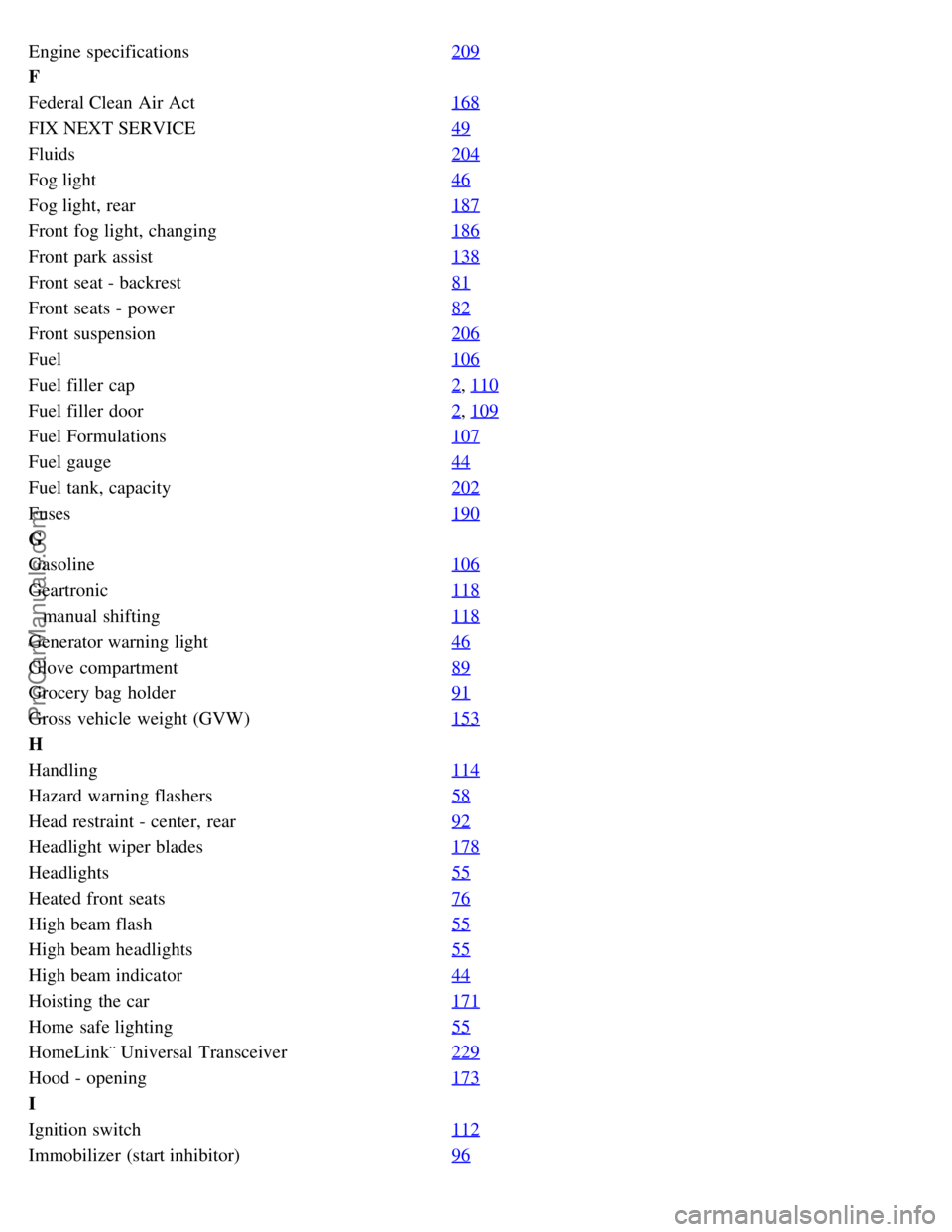
Engine specifications209
F
Federal Clean Air Act168
FIX NEXT SERVICE49
Fluids204
Fog light46
Fog light, rear187
Front fog light, changing186
Front park assist138
Front seat - backrest81
Front seats - power82
Front suspension206
Fuel106
Fuel filler cap2, 110
Fuel filler door2, 109
Fuel Formulations107
Fuel gauge44
Fuel tank, capacity202
Fuses190
G
Gasoline106
Geartronic118
manual shifting118
Generator warning light46
Glove compartment89
Grocery bag holder91
Gross vehicle weight (GVW)153
H
Handling114
Hazard warning flashers58
Head restraint - center, rear92
Headlight wiper blades178
Headlights55
Heated front seats76
High beam flash55
High beam headlights55
High beam indicator44
Hoisting the car171
Home safe lighting55
HomeLink¨ Universal Transceiver229
Hood - opening173
I
Ignition switch112
Immobilizer (start inhibitor)96
ProCarManuals.com
Page 197 of 200
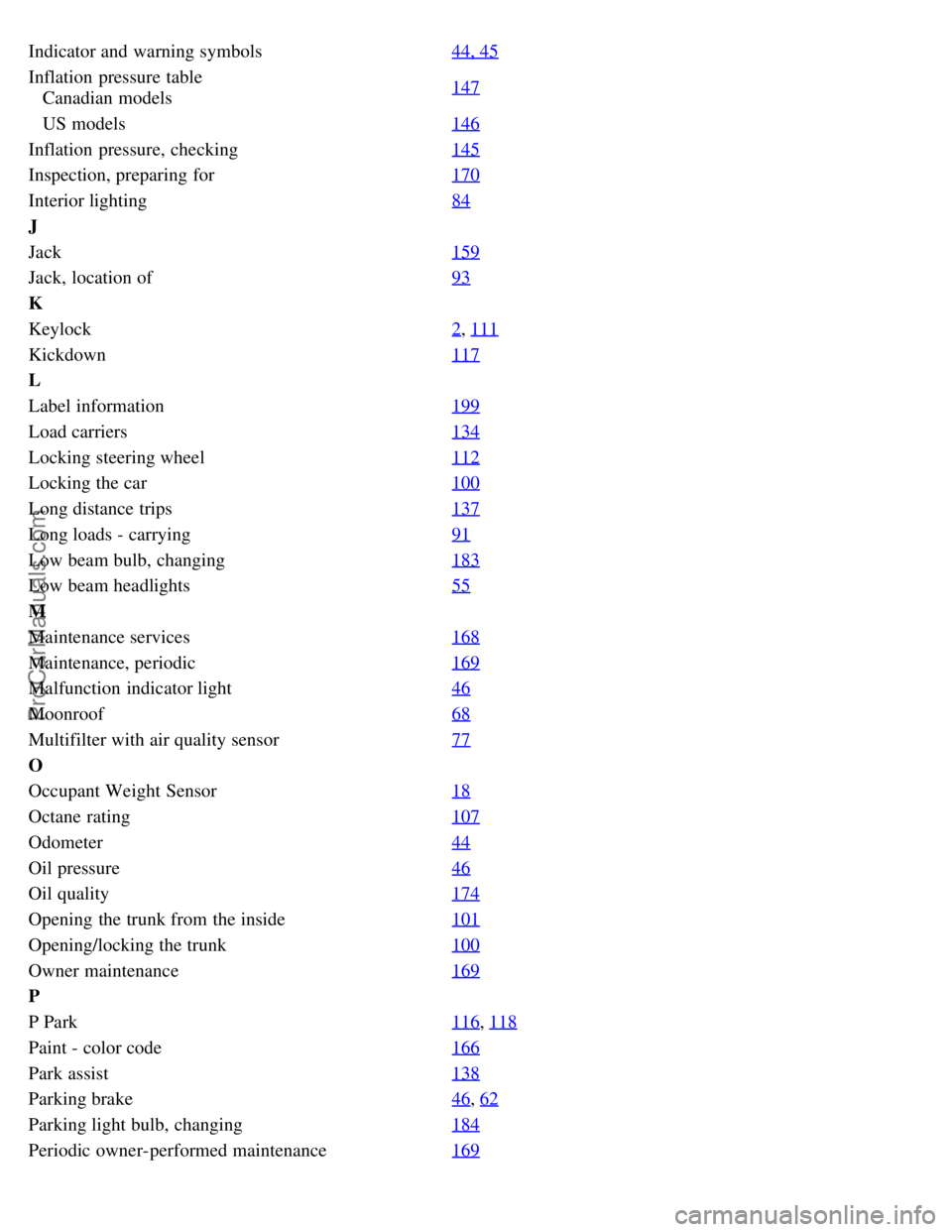
Indicator and warning symbols44, 45
Inflation pressure table
Canadian models147
US models
146
Inflation pressure, checking145
Inspection, preparing for170
Interior lighting84
J
Jack159
Jack, location of93
K
Keylock2
, 111
Kickdown117
L
Label information199
Load carriers134
Locking steering wheel112
Locking the car100
Long distance trips137
Long loads - carrying91
Low beam bulb, changing183
Low beam headlights55
M
Maintenance services168
Maintenance, periodic169
Malfunction indicator light46
Moonroof68
Multifilter with air quality sensor77
O
Occupant Weight Sensor18
Octane rating107
Odometer44
Oil pressure46
Oil quality174
Opening the trunk from the inside101
Opening/locking the trunk100
Owner maintenance169
P
P Park116
, 118
Paint - color code166
Park assist138
Parking brake46, 62
Parking light bulb, changing184
Periodic owner-performed maintenance169
ProCarManuals.com
Page 199 of 200
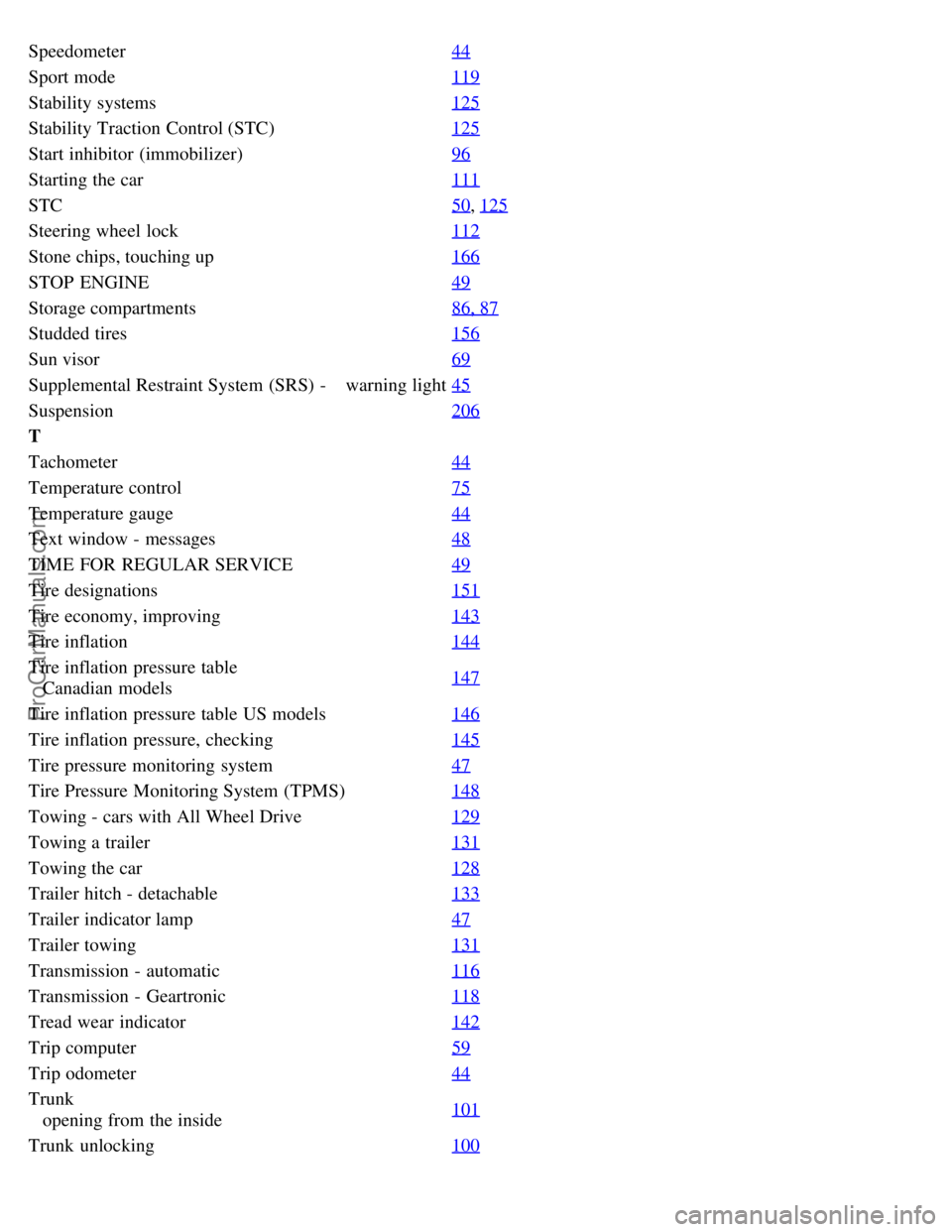
Speedometer44
Sport mode119
Stability systems125
Stability Traction Control (STC)125
Start inhibitor (immobilizer)96
Starting the car111
STC50, 125
Steering wheel lock112
Stone chips, touching up166
STOP ENGINE49
Storage compartments86, 87
Studded tires156
Sun visor69
Supplemental Restraint System (SRS) - warning light45
Suspension206
T
Tachometer44
Temperature control75
Temperature gauge44
Text window - messages48
TIME FOR REGULAR SERVICE49
Tire designations151
Tire economy, improving143
Tire inflation144
Tire inflation pressure table
Canadian models147
Tire inflation pressure table US models
146
Tire inflation pressure, checking145
Tire pressure monitoring system47
Tire Pressure Monitoring System (TPMS)148
Towing - cars with All Wheel Drive129
Towing a trailer131
Towing the car128
Trailer hitch - detachable133
Trailer indicator lamp47
Trailer towing131
Transmission - automatic116
Transmission - Geartronic118
Tread wear indicator142
Trip computer59
Trip odometer44
Trunk
opening from the inside101
Trunk unlocking
100
ProCarManuals.com